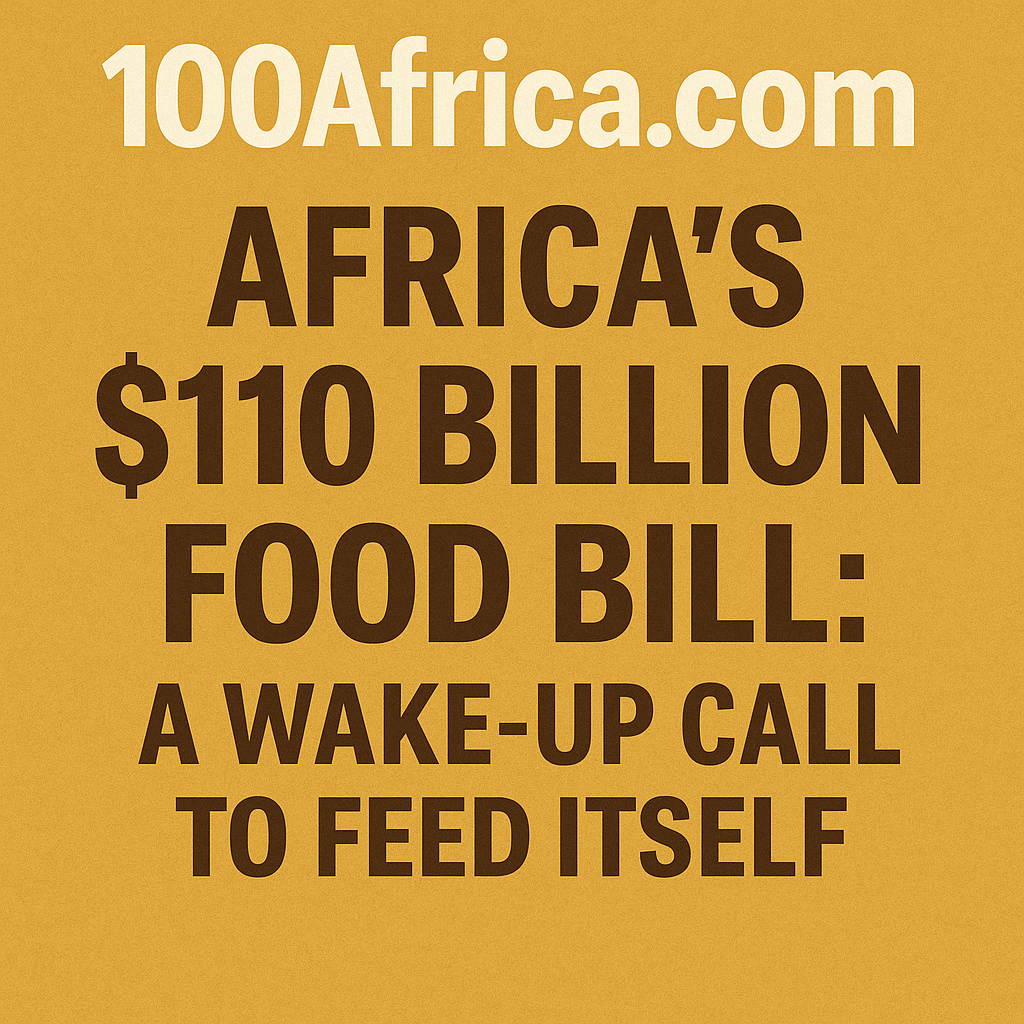
By 100Africa.com News Desk
NAIROBI, Kenya – A new report from 100Africa.com has highlighted the 30 African nations most reliant on food imports from outside the continent, revealing a sharp and unsustainable increase in foreign-sourced food spending that now threatens Africa’s economic resilience and food sovereignty.
The findings, derived from a comprehensive review of trade data between 2020 and 2024, indicate that Africa’s total food import bill is on track to exceed $110 billion by 2025—a significant increase from $50 billion just five years ago. Behind this staggering figure lies a heavy concentration of the burden: just 30 countries are responsible for nearly the entire bill, and most of it goes to importing cereals, vegetable oils, sugar, and processed foods from non-African suppliers.
Egypt Leads a Growing Club of Import-Heavy Nations
Egypt tops the list as Africa’s leading food importer, spending between $10 billion and $ 12 billion annually on essentials such as wheat, maize, and vegetable oils. With its massive population and long-standing food subsidy programs, Egypt is deeply exposed to global commodity price volatility.
Close behind is Nigeria, Africa’s most populous country, whose annual food import bill ranges from $8–10 billion. Nigeria’s growing urban middle class is driving demand for dairy, poultry, and processed foods—products the country largely imports due to limited local processing capacity.
South Africa, often hailed as the continent’s most developed agricultural economy, comes in third. Despite being a food exporter in many categories, it spends $7–8 billion importing rice, wheat, and palm oil, primarily from Asia and South America.
Algeria and Morocco round out the top five, each spending $5–7 billion annually on cereals and dairy, sourced mainly from the European Union.
From Kenya to Côte d’Ivoire: Who Else Is Importing Big?
Countries like Kenya, Ghana, Ethiopia, Côte d’Ivoire, and Tunisia also feature prominently on the list. Each of them spends $2–4 billion per year importing food items that could, with investment and strategic planning, be produced and processed within Africa. For instance, Ghana—one of the world’s top cocoa producers—imports raw cocoa beans for processing, highlighting the deep inefficiencies in domestic value chains.
Even smaller economies, such as Rwanda, Botswana, and Eswatini, are incurring significant food import bills relative to their size, primarily due to growing urban demand and underdeveloped food industries.
What Are These Countries Buying?
The report identifies four dominant food categories accounting for more than half of all imports:
- Cereals (especially wheat, rice, and maize)
- Vegetable oils (primarily palm oil from Southeast Asia)
- Sugar and confectionery
- Processed and ready-to-eat foods (noodles, biscuits, sauces)
These products are sourced mainly from Russia, Ukraine, India, Thailand, Indonesia, Brazil, and the EU, creating dependency risks tied to geopolitical tensions, trade policy shifts, and climate disruptions in supplier regions.
Top 30 African Food Importing Countries – Extra-Continental Dependence
| Rank | Country | Annual Food Imports (Est.) | Top Products from Outside Africa |
|---|---|---|---|
| 1 | Egypt | $10–12B | Wheat, maize, vegetable oils |
| 2 | Nigeria | $8–10B | Wheat, dairy, sugar |
| 3 | South Africa | $7–8B | Rice, wheat, palm oil |
| 4 | Algeria | $6–7B | Wheat, dairy, maize |
| 5 | Morocco | $5–6B | Wheat, maize, sugar |
| 6 | Ethiopia | $3–4B | Wheat, rice, processed foods |
| 7 | Kenya | $3–4B | Wheat, palm oil, rice |
| 8 | Ghana | $2.8–3.5B | Cereals, meat, cocoa (imported) |
| 9 | Côte d’Ivoire | $2–3B | Rice, dairy, palm oil |
| 10 | Tunisia | $2–3B | Cereals, dairy, processed foods |
| 11 | Sudan | $1.8–2.2B | Wheat, sugar, vegetable oil |
| 12 | Angola | $1.5–2.0B | Rice, flour, poultry |
| 13 | Senegal | $1.5–2.0B | Rice, sugar, processed foods |
| 14 | Tanzania | $1.3–1.8B | Wheat, palm oil, sugar |
| 15 | Mozambique | $1.2–1.6B | Wheat, rice, edible oils |
| 16 | Cameroon | $1.2–1.5B | Wheat, sugar, poultry |
| 17 | Uganda | $1.1–1.4B | Rice, wheat, processed foods |
| 18 | Zambia | $1.0–1.3B | Cereals, poultry, sugar |
| 19 | Zimbabwe | $0.9–1.2B | Maize, wheat, meat |
| 20 | Namibia | $0.9–1.1B | Poultry, wheat, dairy |
| 21 | DR Congo | $0.8–1.1B | Cereals, oils, dairy |
| 22 | Malawi | $0.7–1.0B | Wheat, sugar, cooking oil |
| 23 | Mali | $0.6–0.9B | Rice, wheat, sugar |
| 24 | Burkina Faso | $0.6–0.9B | Wheat, processed foods, oils |
| 25 | Niger | $0.5–0.8B | Wheat, milk powder, sugar |
| 26 | Rwanda | $0.5–0.7B | Rice, processed foods, dairy |
| 27 | Chad | $0.4–0.6B | Cereals, oils, processed foods |
| 28 | Botswana | $0.4–0.6B | Meat, cereals, dairy |
| 29 | Lesotho | $0.3–0.5B | Processed foods, cereals, dairy |
| 30 | Eswatini | $0.3–0.5B | Rice, cooking oil, sugar |
Why This Matters
Africa’s growing food import bill doesn’t just reflect trade—it reveals structural weaknesses:
- Low agricultural productivity
- Underdeveloped food processing
- Poor transport and cold chain infrastructure
- Weak intra-African trade
The 100Africa.com report concludes with a call to action: build local value chains, invest in agro-processing, and strengthen regional food systems through platforms like the African Continental Free Trade Area (AfCFTA).
Bottom Line:
Africa’s top 30 food-importing countries are exporting billions in potential value each year. Until the continent produces and processes more of its own food, it will remain at the mercy of foreign suppliers—and exposed to every global crisis that follows.
